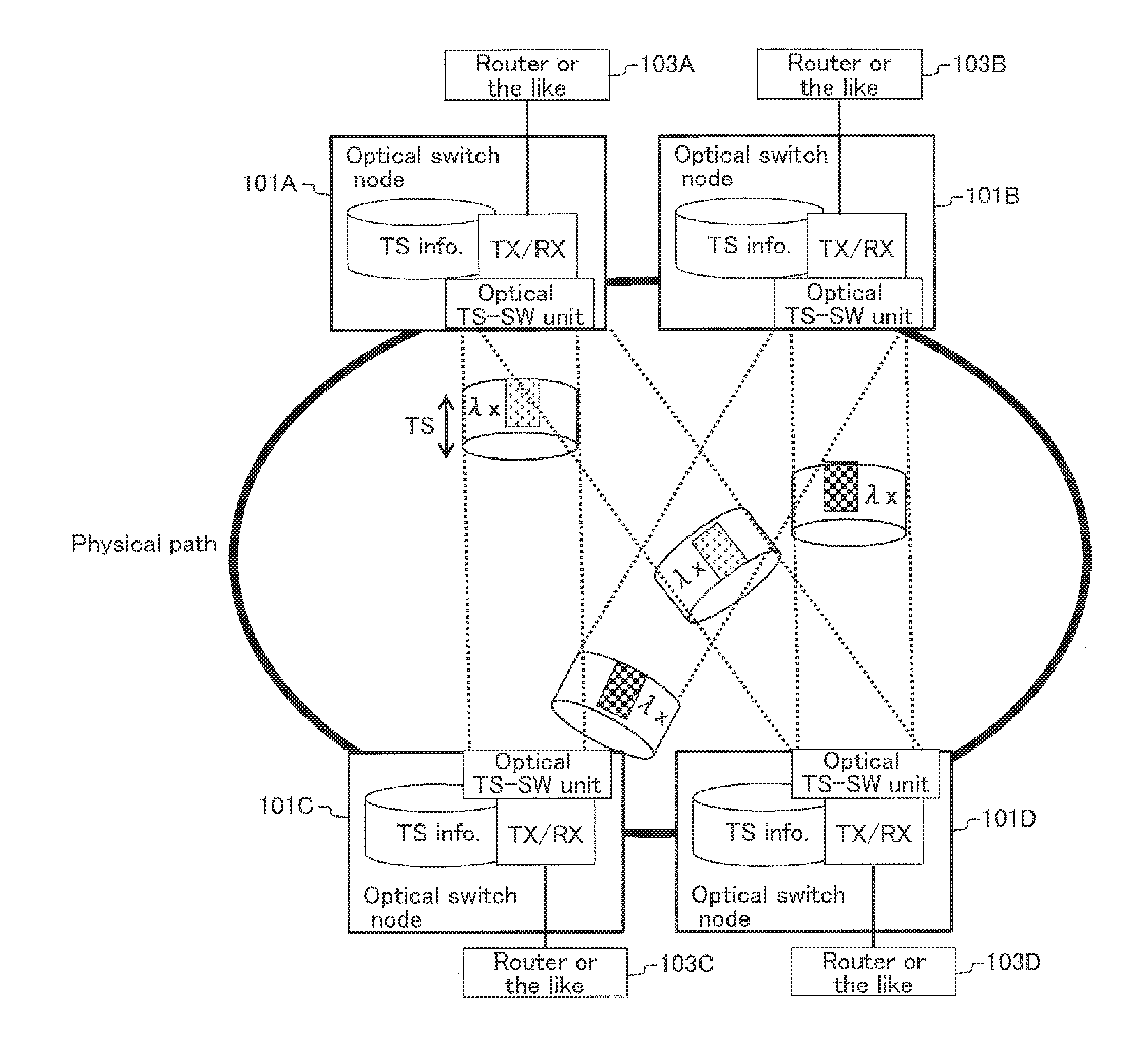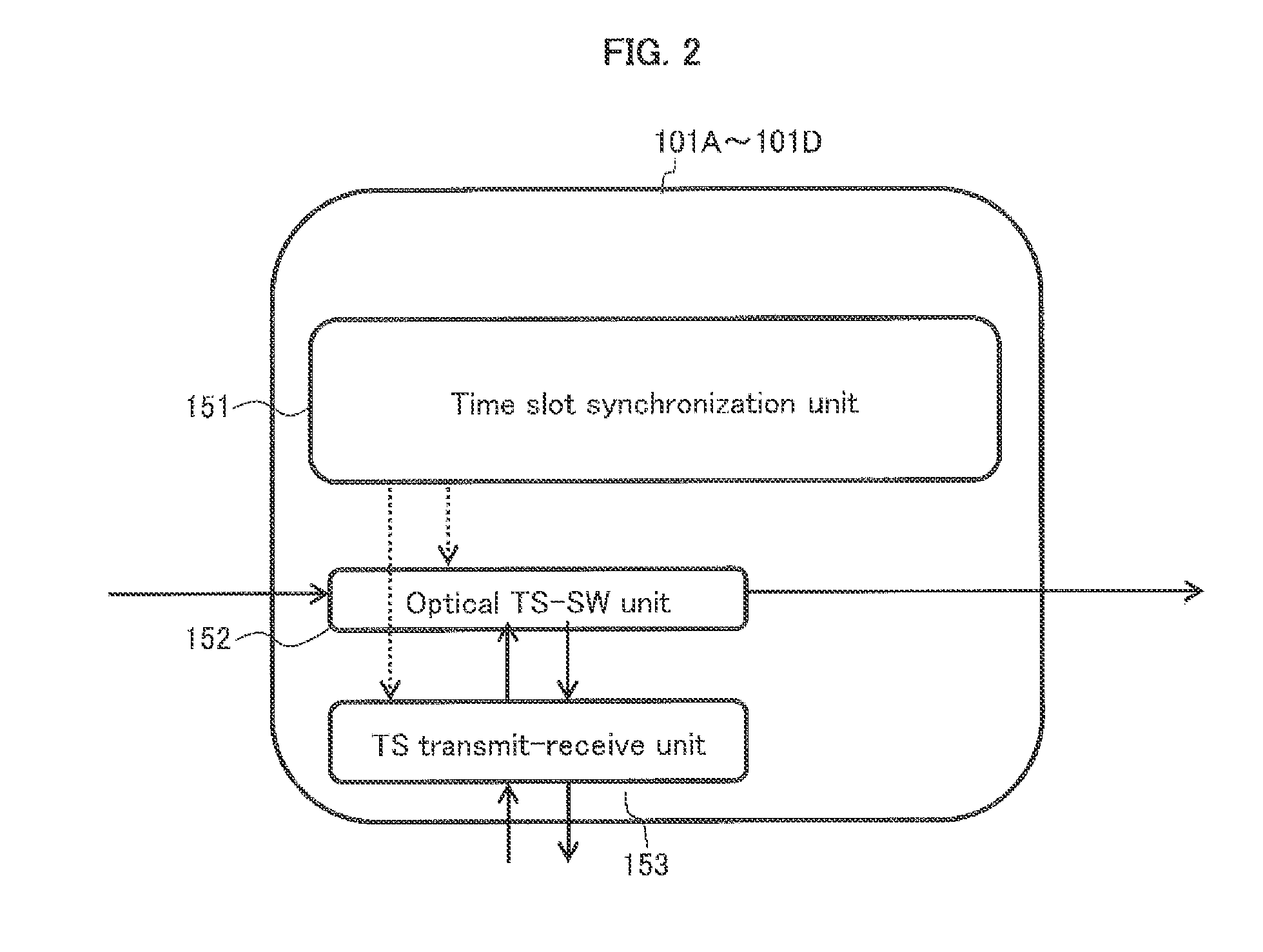Optical network system, optical switch node, master node, and node
a network system and optical switch technology, applied in the field of optical switch nodes, master nodes, and nodes, can solve the problems of not being able to use one free bandwidth, not being able to transmit or receive part of data, and improving bandwidth, so as to improve increase the number of nodes , the effect of improving the efficiency of traffic accommodation
- Summary
- Abstract
- Description
- Claims
- Application Information
AI Technical Summary
Benefits of technology
Problems solved by technology
Method used
Image
Examples
first embodiment
[0246]In the optical network system according to the first embodiment, when the master node transmits a trigger to each of nodes, time slots (TSs) of the nodes are synchronized. The master node then sets a TS length or a TS period at one over the integers. This makes it possible to match a timing at which the trigger is terminated at the master node after one round of a ring, and a timing at which another trigger is outputted, thus allowing periodic data transmission and receipt to be realized in the ring network.
[0247]Next is described a configuration of the optical switch node according to this embodiment.
[0248]FIG. 3 is a block diagram illustrating an example of a configuration of an optical switch node 1 according to this embodiment. FIG. 4 is a diagram schematically illustrating transmission routes of a control signal and an optical signal in the optical switch node 1 illustrated in FIG. 3. Broken arrows show directions in which the control signal is transmitted, and solid arro...
second embodiment
[0308]A second embodiment is configured such that time slot information is embedded in a trigger and is delivered to a node with the trigger embedded therein.
[0309]FIG. 21 is a block diagram illustrating a configuration example of an optical switch node 1E according to a second embodiment. FIG. 22 is a diagram schematically illustrating transmission routes of a control signal and an optical signal in the optical switch node 1E illustrated in FIG. 21.
[0310]As illustrated in FIG. 21, the optical switch node 1E according to the second embodiment does not include the TS information management unit 10 illustrated in FIG. 3. Meanwhile, in the second embodiment, as illustrated in FIG. 22, the trigger detection unit 21 transfers, upon receipt of a trigger, the TS information embedded in the trigger, to the transmission control unit 23 and the optical SW control unit 22.
[0311]FIG. 23 is a block diagram illustrating a configuration example of a master optical switch node (a master node) 2E ac...
third embodiment
[0323]An optical network system according to a third embodiment is configured such that a time at a node is set at a time shifted by a transmission delay time, by transmitting a time stamp from a master node. Thus, time slots are synchronized at a time common to all nodes, at which data transmission and receipt can be realized.
[0324]Next is described a configuration of an optical switch node according to this embodiment.
[0325]FIG. 26 is a block diagram illustrating a configuration example of an optical switch node 1F according to the third embodiment. FIG. 27 is a diagram schematically illustrating transmission routes of a control signal and an optical signal in the optical switch node 1F illustrated in FIG. 26.
[0326]As illustrated in FIG. 26, the optical switch node 1F includes a TS information management unit 10 that sets TS information; a TS synchronization unit 25; a time counter 70; an optical TS-SW unit 30; and a TS transmit-receive unit 40. The TS synchronization unit 25 incl...
PUM
 Login to View More
Login to View More Abstract
Description
Claims
Application Information
 Login to View More
Login to View More - R&D
- Intellectual Property
- Life Sciences
- Materials
- Tech Scout
- Unparalleled Data Quality
- Higher Quality Content
- 60% Fewer Hallucinations
Browse by: Latest US Patents, China's latest patents, Technical Efficacy Thesaurus, Application Domain, Technology Topic, Popular Technical Reports.
© 2025 PatSnap. All rights reserved.Legal|Privacy policy|Modern Slavery Act Transparency Statement|Sitemap|About US| Contact US: help@patsnap.com



